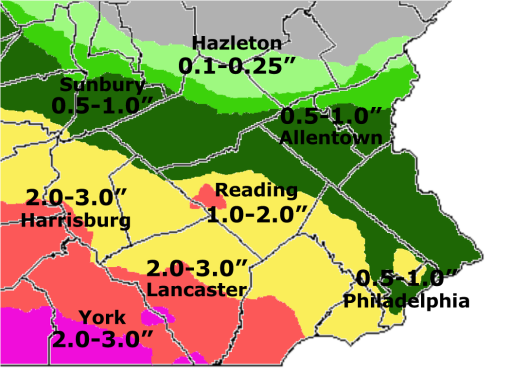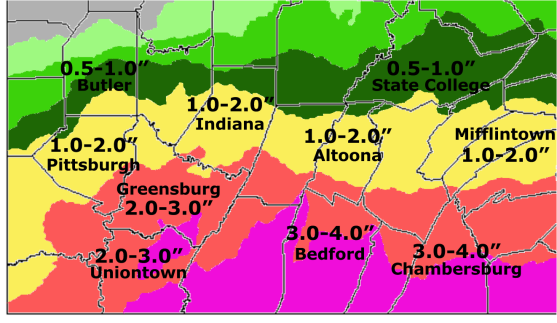Over the past 7 to 10 days, many parts of Pennsylvania have had to deal with their fair share of wet weather. Between severe thunderstorms and slow-moving systems, some areas have seen as much as 10 inches of rain.
Unfortunately, more of the same is expected towards the end of this week as we see a 1-2 punch of severe thunderstorms and heavy rainfall. Here’s the breakdown of what to expect:
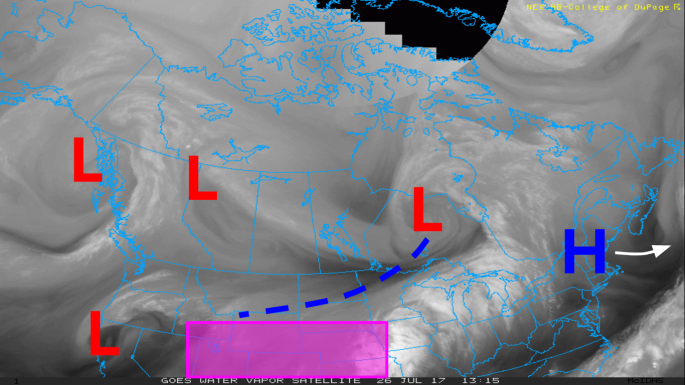
Looking at the current water vapor image across the US and Canada, there are a couple of features to note. First is our high pressure over the Northeast, providing us with a dry Wednesday afternoon. That’s going to be departing the region over the next 12-18 hours.
Behind that we have a strong low pressure system over Ontario, with a trailing cold front draped over Minnesota and the Dakotas. Also, we have a monsoonal low sitting over Colorado and Kansas, carrying with it plenty of moisture, as indicated by the convection over the central Plains. These two pieces will help to form Thursday’s thunderstorm risk.
Normally this would be a good setup for strong to severe thunderstorms, as we will have strong thermal gradients in place on Thursday. There’s no shortage of “fuel” for these thunderstorms. However, energy and vorticity to help those storms ignite will be lacking.
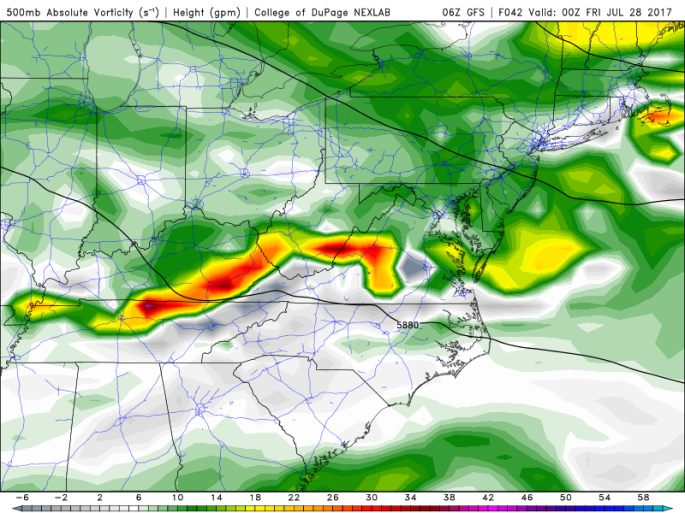
Above is the 500mb absolute vortcity (GFS) for 8pm Thursday. You’ll note that the NW-SE flow has steered the energy from our monsoonal low way south. As a result, the Virginias, North Carolina, and Kentucky are in prime position for severe thunderstorms. Us? Not so much. (except perhaps far SW PA)
Farther north, we will still have our cold front pushing through the region, meaning that some thunderstorms are not out of the question. This front, while not an overly impressive trigger in-and-of-itself, will have marginal support ahead of it across PA and NY to spark some isolated activity. The isolated part is important. Many places will remain dry on Thursday with the passage of this front. But any storms that do develop will have a fairly good chance of going severe, with damaging winds the primary concern. A severe thunderstorm outlook for tomorrow will be posted sometime tonight.
So overall, Thursday isn’t a major deal.
Then things get really abnormal for late July standards. Our low pressure over the Ohio Valley and Mid-Atlantic on Thursday will move across the Appalachians and weaken. However, the energy from this system will transfer to an additional area of low pressure off of the Delmarva and southern NJ coast for Friday. This is a setup more typical of late fall/winter, rather than summer. It’s basically a “Miller-B” storm.
For those not familiar with a “Miller-B” storm, below is a diagram. It’s not a perfect representation of how our system will play out, but it is fairly close. Obviously since this is summer, we won’t be seeing any snow out of it. 😦
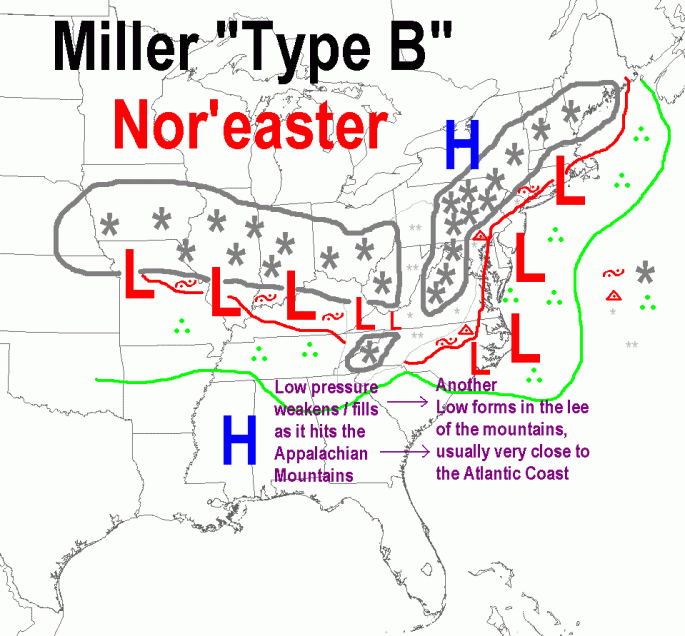
We have our remnant monsoonal low pushing eastward across KY/WV/VA. As it hits the Appalachian mountains, another low pressure forms on the eastern side, somewhere in the Delmarva/S NJ/N VA region. This becomes our primary system as it rapidly strengthens (cyclogenesis) as it pushes northeast.
The major question regarding this storm is “where does it form?”. This is dependent on where our Thursday’s cold front-turned-stalled boundary parks. If it were to setup over southern PA/southern NJ, the majority of the state would see heavy rainfall and locally severe thunderstorms. If the boundary is further south (say over N VA-E MD), our odds of heavy rain reduce dramatically. 50-75 miles could be the difference between 0.50″ and 2-4″ of rain.
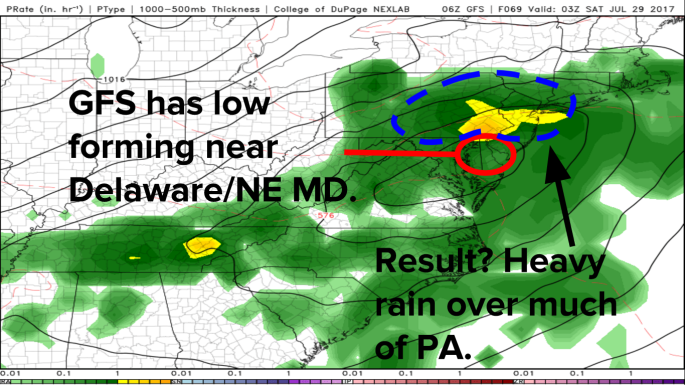
It’s pointless to post every model run, as the will all change over the next 24-48 hours. But just for reference, above is the 6z GFS run from this morning. In my opinion, this is a fairly reasonable solution. The Euro is farther southwest by about 40 miles, which is another plausible placement. The NAM has pretty much gone of its wheels, as it develops the system over SE VA (WAY too far south).
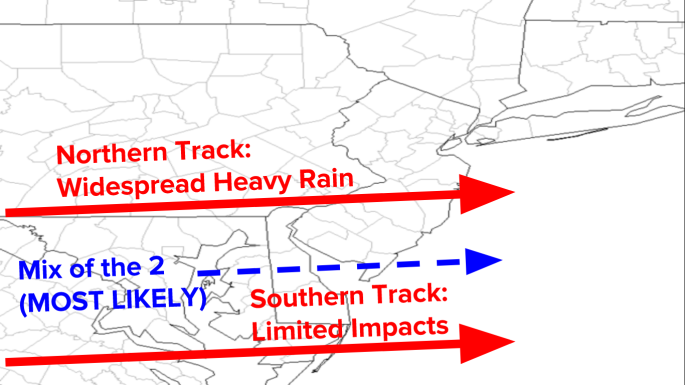
Taking in all the guidance, this appears to be the parameters for our system. There is still plenty of time to iron out the details, and of course, this has the potential to change and adjust.
Nevertheless, as our Nor’easter strengthens off the NJ/Long Island coast, we see winds back in from the northeast, bringing a heavy marine layer over the region. Add in gusty winds in the range of 20-35mph, temperatures in the 60s and low 70s, and we’ll certainly have a raw end to the week.
Due to these strong, gusty winds and grounds being saturated from recent rains, downed trees and power outages may become an issue, especially across eastern PA. Typically winds of this strength would not be a major problem, but in this Friday’s case it could prove otherwise.
Clouds and showers will likely linger into Saturday morning, before the system finally departs.
